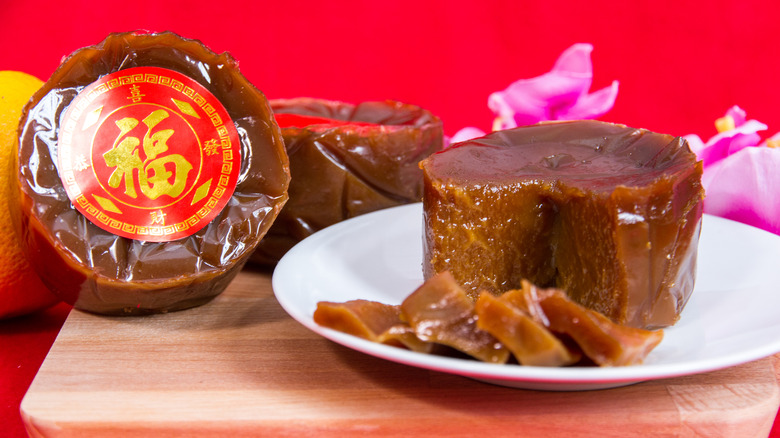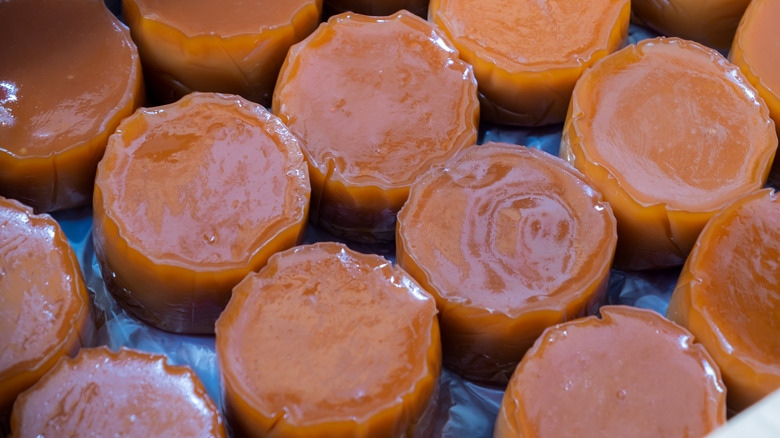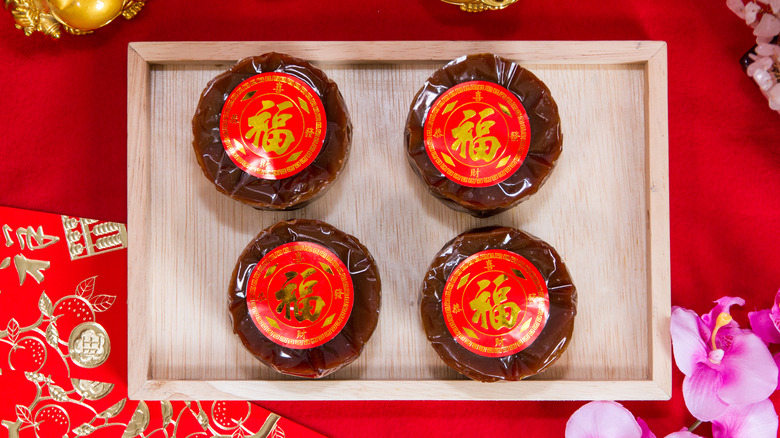The Chinese Cake That Signifies Good Luck For The Lunar New Year
When celebrating the Lunar New Year, Chinese tradition states that certain dishes will bring extra luck for the year ahead. Dumplings and spring rolls, for example, are thought to signify wealth, while tangyuan, or sweet rice balls, might help you become a little closer to your family. Eating certain types of fish is said to bring a variety of fortune.
One of those lucky foods is nian gao. It is a glutinous, sticky rice cake made from glutinous rice flour, sweet brown sugar, and a little bit of water. Some variations of the cake also call for added ingredients — like coconut, red bean paste, sesame, or pandan — but the traditional dessert can be kept pretty simplistic.
Different regions serve different versions of the cake. In Northern China, it's more common to see ingredients like jujubes, sweet red bean paste, or green beans added to glutinous or yellow rice to make the cakes. In the east, however, it's more common to see white rice forming the cakes. It's used in savory applications, and sometimes served with pork, beef, or veggies. Cantonese nian gao is especially sticky and can be pan fried. Fujian or Hokkien nian gao can be a little more filling, thanks to the addition of fruits, nuts, seeds, or dates.
If you're looking to get ahead in the workforce, you may want to bite into one of these sweet cakes. They've been said to provide a little extra luck for some prosperity in the new year.
The cakes could benefit both work and school
In Chinese, nian gao is pronounced the same way as the term "year high." This can take on several meanings, depending on what you're trying to manifest by eating the cakes made with light or dark brown sugar. In terms of work, it could mean that your business will boom, you may receive a promotion, or that a big raise is headed your way. Of course, you will still need to work for those things yourself — but having a little extra luck on your side never hurts.
For those who may be a little too young to enter the workforce, the sweet, sticky cakes can still bring good luck in a few regards. The cakes could bring good luck for children hoping to grow a few inches taller — though it may cause a little conflict between siblings along with those bragging rights. If you're hoping to do a little better in school, that success and growth can also transfer over to your grades.
The rice cakes have proved lucky in several stories
There are a few different stories surrounding the rice cake. One tale says that a Nian was a toothy, horned, dog-like monster with wild hair. It terrorized villages each winter until the Gao family decided to feed it sticky rice cakes. After it was full, it retreated to the mountains. This legend is still accepted and celebrated today. During Lunar New Year parades, reenactments of the story can be seen in parades and festivals.
Another story says that nian gao saved the Wu people from starvation when the food supply was cut off during a siege in pre-Imperialist China. While the citizens were in hiding, they found preserved sweet, sticky rice cakes to eat underneath walls built by General Wu Zixu. A third legend says that the "Kitchen God" makes yearly reports to the Jade Emperor regarding the quality of people's homes. In order to prevent a poor report, the rice cakes are prepared as an offering. The sticky texture is thought to keep the god's mouth closed — and that no report is better than a bad report.
If you're celebrating the Lunar New Year, you might want to add some nian gao to your table. The sweet, sticky rice cakes might just give you a little extra luck to accomplish your goals for the year.


